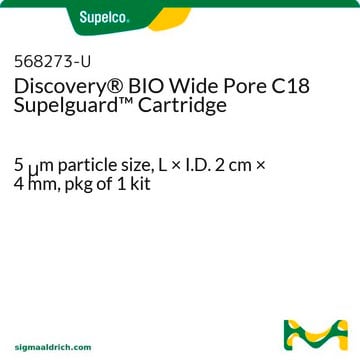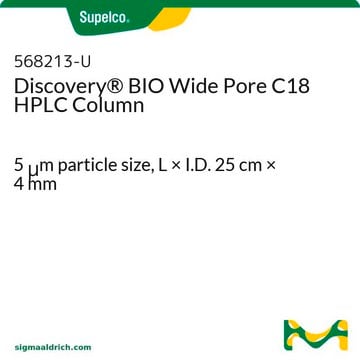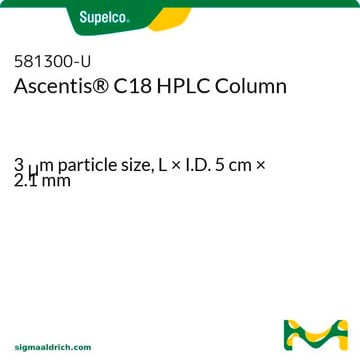Reverse Phase Column Rehydration Method:
1. The column should ideally not contain any buffer. If it does, thoroughly flush the column with water to remove the buffer.
2. Flush the column with 100% acetonitrile, starting at a flow rate of 0.3-0.5 ml/minute. Slowly increase the flow rate to 1 ml/minute, flushing for approximately 30 minutes, as long as the pressure does not excessively increase.
3. Equilibrate the column with the mobile phase specified on the Certificate of Analysis (CofA) of the column, and run a test mix similar to what was used to test the column.
4. If the performance is unsatisfactory, repeat the method, increasing the flushing with acetonitrile for one hour.
5. Repeat the test. If the performance is still not as expected, the column may have degraded.
568223-U
Discovery® BIO Wide Pore C18 (5 µm) HPLC Columns
L × I.D. 25 cm × 4.6 mm
Sinônimo(s):
Wide Pore C18 HPLC Column
About This Item
Produtos recomendados
Nome do produto
Discovery® BIO Wide Pore C18 HPLC Column, 5 μm particle size, L × I.D. 25 cm × 4.6 mm
Materiais
stainless steel column
Nível de qualidade
Agency
suitable for USP L1
linha de produto
Discovery®
Características
endcapped
fabricante/nome comercial
Discovery®
embalagem
1 ea of
Extensão da rotulagem
9.2% Carbon loading
Parâmetros
0-70 °C temperature
400 bar pressure (5801 psi)
técnica(s)
HPLC: suitable
LC/MS: suitable
C × D.I.
25 cm × 4.6 mm
área da superfície
100 m2/g
cobertura de superfície
3.6 μmol/m2
Matriz
silica particle platform
fully porous particle
Grupo ativo da matriz
C18 (octadecyl) phase
tamanho de partícula
5 μm
tamanho de poro
300 Å
pH operacional
2-8
técnica de separação
reversed phase
Procurando produtos similares? Visita Guia de comparação de produtos
Descrição geral
Aplicação
- Kinetic performance comparison of superficially porous, fully porous and monolithic reversed-phase columns by gradient kinetic plots for the separation of protein biopharmaceuticals.: This study provides a detailed kinetic performance comparison of different types of reversed-phase HPLC columns, including the Discovery® BIO Wide Pore C18 HPLC Column. The research highlights its efficiency and resolution in separating complex protein biopharmaceuticals, making it a valuable tool for analytical chemists in biopharmaceutical analysis (Jaag et al., 2022).
- RP-LC x RP-LC analysis of a tryptic digest using a combination of totally porous and partially porous stationary phases.: This paper investigates the use of reverse-phase liquid chromatography (RP-LC) with both totally porous and partially porous stationary phases, including the BIO Wide Pore C18 HPLC Column, to analyze tryptic digests. The findings demonstrate its robustness and high resolution in proteomics applications, enabling precise peptide mapping and protein characterization (Mondello et al., 2010).
Informações legais
Aplicação
pré-cartucho
Escolha uma das versões mais recentes:
Já possui este produto?
Encontre a documentação dos produtos que você adquiriu recentemente na biblioteca de documentos.
Os clientes também visualizaram
Conteúdo relacionado
DiscoveryBIO Wide Pore C18 products offered by Sigma-Aldrich.
Chromatograms
application for HPLC-
What is the method for rewetting a column that may have dried as a result of the end cap being loose or not being used for an extended period of time?
1 answer-
Helpful?
-
-
WHIGH SOLVENT USED FOR WASHING OF COLUMN
1 answer-
See below for a general cleaning protocol:
1. Reverse the orientation of the column
2. Flush for a few minutes, or >1 column volume, with a 20% solution in water, of the organic used in the analysis, such as methanol or acetonitrile. This is to remove any residual buffer salts.
3. Flush for approximately 30 mins, or >10 column volumes, with 100% of the organic solvent used in the analysis.
4. The column can be stored with this organic solvent until ready for use.
5. Before reusing the column, flush again, as per step 2.Helpful?
-
Active Filters
Nossa equipe de cientistas tem experiência em todas as áreas de pesquisa, incluindo Life Sciences, ciência de materiais, síntese química, cromatografia, química analítica e muitas outras.
Entre em contato com a assistência técnica










